Asia has a rich culinary heritage, with diverse diets that have evolved through centuries of cultural influences. The history of food in Asia is a fascinating journey that encompasses a wide range of cuisines and flavours. From traditional Asian diets to modern adaptations, the food culture in Asia has played a significant role in shaping the region’s identity.
In this article, we will delve into the past and present diets of Asia, exploring the historical significance and evolution of Asian cuisines throughout history. We will uncover the traditional Asian diet, known for its emphasis on plant foods such as rice, vegetables, and fresh fruits. Unlike many Western diets, meat is rarely the main dish in Asian cuisine, with fish often taking the spotlight in main courses.
One of the remarkable aspects of the Asian diet is its association with better health outcomes. Studies have shown that Asian dietary practices are linked to lower rates of chronic illnesses like heart disease, cancer, and obesity. The emphasis on whole, unprocessed foods and a balance of nutrients contributes to the overall well-being of individuals who follow the Asian diet.
Asia is a vast continent with diverse culinary traditions. Each region boasts its own unique cuisine, showcasing a blend of flavours, techniques, and ingredients. For example, Indonesia offers a wide variety of traditional foods influenced by its rich cultural heritage. Japan is known for its rice and fish-based dishes, while Korean cuisine is a fusion of Chinese and Japanese influences.
The Asian diet pyramid provides a visual representation of the recommended food groups and portion sizes in the Asian diet. It emphasizes grains, vegetables, fruits, nuts, and legumes, with moderation in meat and dairy consumption. By following this pyramid, individuals can maintain a balanced and nutritious diet that promotes optimal health.
Throughout history, Asian diets have evolved due to various factors such as trade, migration, and colonialism. These influences have shaped the culinary landscape of Asia, resulting in a diverse range of dishes and flavours. Asian cuisine continues to adapt and evolve, with modern adaptations and fusion cuisines reflecting the changing lifestyles and influences of globalization.
Staple foods in Asia play a crucial role in the region’s diets. Rice, noodles, and grains are common staples that form the foundation of many Asian dishes. These foods have deep cultural significance and are integral to Asian culinary traditions and dietary habits.
In conclusion, the past and present diets of Asia offer a rich culinary tapestry that is both flavorful and nutritious. The traditional Asian diet, with its focus on fresh, whole foods, provides a blueprint for a healthy lifestyle. As Asian cuisines continue to evolve and adapt to modern influences, it is important to preserve and appreciate the diverse culinary heritage of this vibrant continent.
Key Takeaways:
- The traditional Asian diet is based on plant foods such as rice, vegetables, and fresh fruits.
- Meat is rarely the main dish in Asian cuisine, with fish often taking the spotlight in main courses.
- Asian dietary practices are associated with lower rates of chronic illnesses like heart disease, cancer, and obesity.
- Each region in Asia has its own unique cuisine, influenced by its cultural heritage.
- The Asian diet pyramid emphasizes grains, vegetables, fruits, nuts, and legumes, with moderation in meat and dairy consumption.
Traditional Asian Diets
The traditional Asian diet is primarily plant-based, with vegetables, grains, and fruits forming the foundation of most meals. Meat is rarely the main dish, and when consumed, it is often in smaller portions. Fish, on the other hand, takes centre stage in many Asian cuisines and is commonly enjoyed in main courses. This emphasis on plant foods and seafood contributes to the healthful qualities associated with the Asian diet.
Asian cuisines have a rich history that spans centuries, with each region boasting its unique culinary traditions. In Indonesia, for example, a diverse array of traditional foods can be found, influenced by the country’s rich cultural heritage and abundance of natural resources. In Japan, rice and fish-based dishes are staples, showcasing the country’s close relationship with the sea. Korean food, with its blend of Chinese and Japanese influences, is known for its bold flavours and generous use of fermented ingredients.
The Asian Diet Pyramid serves as a visual representation of the recommended food groups and portion sizes in the traditional Asian diet. It emphasizes the importance of consuming grains, vegetables, fruits, nuts, and legumes in generous amounts, while meat and dairy are enjoyed in moderation. This balance of nutrient-dense foods provides a wide range of vitamins, minerals, and antioxidants, contributing to the overall well-being of individuals who follow a traditional Asian diet.
| Grains | Vegetables | Fruits | Protein |
|---|---|---|---|
| Rice | Leafy greens | Citrus fruits | Seafood |
| Noodles | Cruciferous vegetables | Apples | Tofu |
| Millet | Root vegetables | Berries | Soy |
When enjoying an Asian meal, it’s common to find the table adorned with a variety of dishes, encouraging communal dining and shared experiences. The flavours, aromas, and textures of Asian dishes are carefully balanced, creating a harmonious and pleasurable eating experience. Fresh ingredients are favoured, with minimal processing, allowing the natural flavours to shine. The traditional Asian diet not only nourishes the body but also satisfies the senses, making it a truly enjoyable way of eating.
Quote
The traditional Asian diet is a testament to the wealth of culinary diversity in the region. From fragrant curries to delicate sushi rolls, each dish tells a story that has been passed down through generations, reflecting the rich history and cultural heritage of Asia.
The traditional Asian diet continues to be celebrated for its healthful qualities and its ability to promote overall well-being. By embracing the principles of the Asian Diet Pyramid and incorporating fresh, whole foods into their meals, individuals can adopt a diet that not only nourishes their bodies but also brings joy to their taste buds.
The Asian diet is renowned for its health benefits, contributing to the lower incidence of chronic diseases in Asian populations. The traditional Asian diet is based on plant foods, such as rice, vegetables, and fresh fruits. These nutrient-dense foods provide a rich source of vitamins, minerals, and antioxidants that support overall well-being and help to prevent various illnesses.
Studies have shown that the Asian diet is associated with lower rates of heart disease, thanks to its emphasis on healthy fats, such as those found in fish, nuts, and seeds. The consumption of fish, in particular, provides essential omega-3 fatty acids, which have been linked to improved cardiovascular health and a reduced risk of heart attacks and strokes.
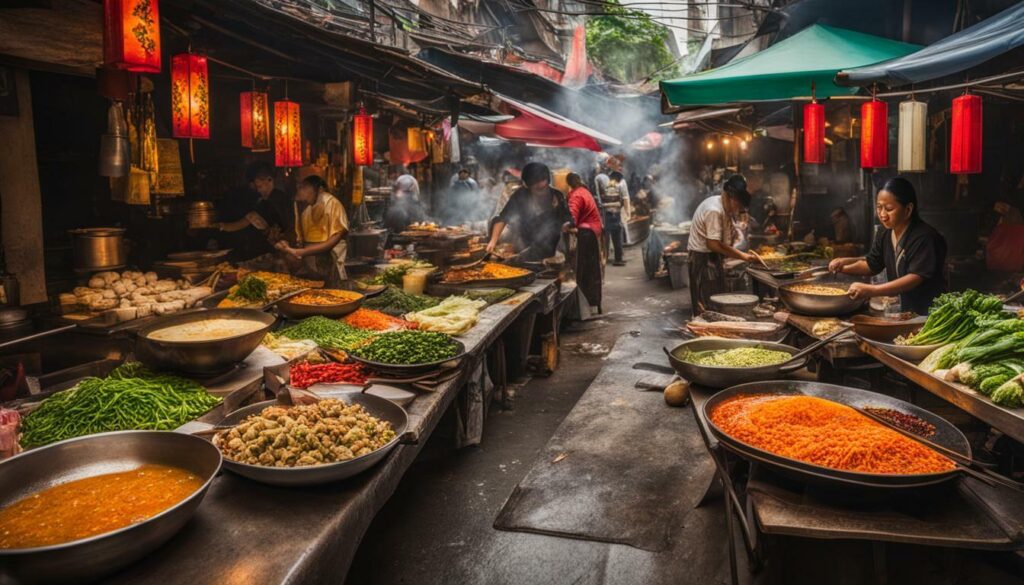
| Lower Rates of Chronic Diseases | Emphasis on Whole, Unprocessed Foods | Balance of Nutrients |
|---|---|---|
| The Asian diet is associated with lower rates of chronic illnesses like heart disease, cancer, and obesity. | The Asian diet emphasizes the consumption of whole, unprocessed foods, which are rich in essential nutrients and free from harmful additives. | The Asian diet provides a balance of carbohydrates, proteins, and fats, as well as a wide range of vitamins, minerals, and antioxidants. |
Furthermore, the Asian diet is typically low in saturated fats and high in fibre, which can help to maintain a healthy weight and lower the risk of obesity. The emphasis on plant-based foods, such as vegetables and legumes, provides a good source of dietary fibre that aids in digestion and promotes a healthy gut microbiome.
The Asian diet also prioritizes the consumption of tea, which is rich in antioxidants and has been associated with a reduced risk of certain cancers. Additionally, Asian cuisines often incorporate spices and herbs, such as turmeric and ginger, which possess anti-inflammatory properties and can contribute to overall health and well-being.
In conclusion, the Asian diet offers numerous health benefits due to its emphasis on whole, unprocessed foods, a variety of fruits and vegetables, and the inclusion of lean proteins like fish. By adopting the principles of the Asian diet, individuals can improve their overall health and reduce the risk of chronic diseases.
Regional Variations in Asian Cuisines
Asia is a treasure trove of culinary diversity, with each region boasting its distinct flavours and cooking styles. From the spicy and aromatic dishes of Thailand to the delicate and intricate creations of China, traditional Asian cuisine is a celebration of taste and texture. Let’s explore some of the popular traditional Asian recipes and foods that have captivated palates for centuries.
Chinese Cuisine: A Blend of Flavours
Chinese cuisine is renowned for its rich and diverse culinary traditions. From the fiery Sichuan dishes to the delicate Cantonese dim sum, Chinese food offers a range of flavours and textures. Traditional Chinese recipes often incorporate a variety of ingredients, including pork, chicken, seafood, tofu, and an array of vegetables. The use of spices and seasonings, such as ginger, garlic, soy sauce, and vinegar, adds depth and complexity to these dishes.
One of the most popular Chinese dishes is Peking duck, a succulent roast duck that is typically served with pancakes, hoisin sauce, and thinly sliced cucumber and spring onions. Another renowned Chinese delicacy is Kung Pao chicken, a spicy stir-fry dish made with chicken, peanuts, and chilli peppers.
Japanese Cuisine: Simple Elegance
Japanese cuisine is known for its simplicity and emphasis on fresh, high-quality ingredients. Traditional Japanese recipes often feature rice, seafood, vegetables, and soy-based seasonings. Sushi, a staple of Japanese cuisine, is a well-known dish that combines vinegared rice with various fillings, such as raw fish or vegetables, wrapped in seaweed. The art of sushi-making requires precision and skill, resulting in beautifully presented and flavorful creations.
Another popular Japanese dish is ramen, a comforting noodle soup that comes in a variety of broths and toppings. Each region in Japan has its unique style of ramen, with variations in the type of noodles used and the flavours of the broth. The combination of umami-rich flavours and chewy noodles makes ramen a beloved comfort food.
Indian Cuisine: A Symphony of Spices
Indian cuisine is renowned for its vibrant flavours and extensive use of spices. Traditional Indian recipes often feature a blend of spices known as masala, which can include combinations of cumin, coriander, turmeric, cardamom, and cinnamon, among others. These spices lend depth and complexity to dishes, creating a symphony of flavours.
One iconic Indian dish is chicken tikka masala, a flavorful chicken curry that combines marinated chicken with a spiced tomato-based sauce. Another popular Indian dish is biryani, a fragrant rice dish that is often made with a variety of meats or vegetables, along with a blend of aromatic spices.
These are just a few examples of the diverse and delicious traditional Asian recipes and foods that can be found across the continent. Whether you’re craving spicy and bold flavours or delicate and subtle tastes, the culinary traditions of Asia are sure to satisfy your appetite and awaken your senses.
Asian Diet Pyramid
The Asian Diet Pyramid offers a clear guide to the balanced eating patterns that have sustained Asian populations for generations. This traditional approach to nutrition emphasizes the consumption of whole, unprocessed foods, with plant-based ingredients taking centre stage. Grains, such as rice and noodles, form the foundation of the Asian diet, providing a rich source of energy and essential nutrients.
Vegetables and fruits, which are abundant in Asian cuisines, accompany every meal, offering a wide range of vitamins, minerals, and fibre. These plant foods are celebrated for their various health benefits and are typically consumed in generous portions. The Asian diet also includes an array of legumes, nuts, and seeds, which provide additional protein, healthy fats, and important micronutrients.
Meat, poultry, and seafood are enjoyed in moderation, often as flavour enhancers rather than the main focus of a dish. Fish, in particular, is a staple source of protein in many Asian diets due to its abundance in coastal regions. Dairy products are not traditionally part of the Asian diet, although fermented foods like yoghurt and tofu are consumed for their probiotic benefits.
| Asian Diet Pyramid | Recommended Servings |
|---|---|
| Grains | 6-11 servings per day |
| Vegetables | 4-6 servings per day |
| Fruits | 3-5 servings per day |
| Legumes, Nuts, and Seeds | 2-3 servings per day |
| Meat, Poultry, and Seafood | 1-2 servings per day |
| Dairy Products | 0-2 servings per day |
By following the Asian Diet Pyramid, individuals can achieve a well-rounded and nutritionally balanced diet. The emphasis on plant-based foods, coupled with limited intake of meat and dairy, promotes cardiovascular health, weight management, and overall well-being. Additionally, the Asian diet encourages mindful eating, with a focus on savouring flavours, textures, and aromas.
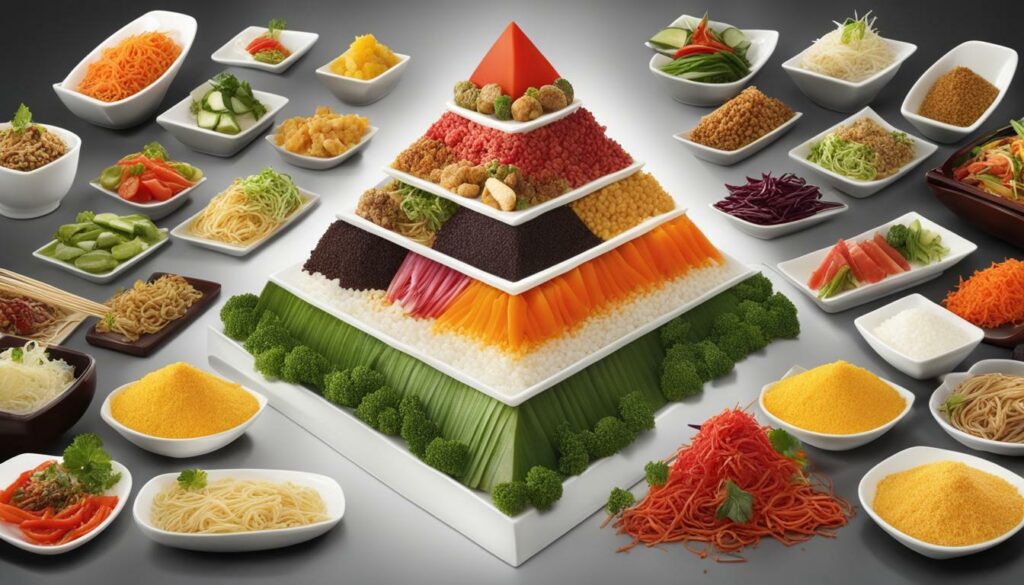
Evolution of Asian Diets
The evolution of Asian diets is a fascinating story that intertwines cultural, economic, and social dynamics. Throughout history, the Asian diet has undergone significant changes influenced by various factors, including trade, migration, and colonialism. These influences have shaped the diverse culinary traditions that can be found across the continent, reflecting the rich tapestry of Asian cultures and societies.
One notable aspect of the evolution of Asian diets is the incorporation of new ingredients and cooking techniques. Trade routes facilitated the exchange of spices, herbs, and culinary practices, resulting in the fusion of flavours and the creation of unique regional cuisines. For example, the blending of Chinese and Indian influences in Malaysian cuisine or the combination of Portuguese and Japanese flavours in Macanese dishes showcases the dynamic nature of Asian culinary traditions.
The evolution of Asian diets is also marked by the impact of globalization and changing lifestyles. As societies became more urbanized and interconnected, the availability of imported foods and the influence of Western dietary patterns led to the integration of new ingredients and cooking styles. This has resulted in modern adaptations and fusion cuisines that cater to evolving tastes and preferences. From Japanese sushi burritos to Korean-inspired tacos, these culinary innovations not only reflect cultural exchanges but also appeal to a younger, more cosmopolitan demographic.
“The blending of cultural and culinary influences has resulted in a vibrant and ever-evolving Asian food scene.”
Despite the changes over time, the traditional Asian diet continues to be prized for its healthful qualities and emphasis on fresh, whole foods. The Asian Diet Pyramid, an updated visual representation of the recommended food groups and portion sizes, underscores the importance of consuming a balanced diet rich in grains, vegetables, fruits, nuts, and legumes. By incorporating these elements in their daily meals, Asians have long benefited from the nutrients and antioxidants found in plant-based foods, contributing to lower rates of chronic diseases such as heart disease, cancer, and obesity.
The evolution of Asian diets is a testament to the resilience and adaptability of Asian cultures. From ancient traditions rooted in local ingredients to contemporary culinary creations influenced by global trends, Asian cuisine continues to captivate and inspire. The blending of cultural and culinary influences has resulted in a vibrant and ever-evolving Asian food scene, celebrated not only within Asia but across the world.
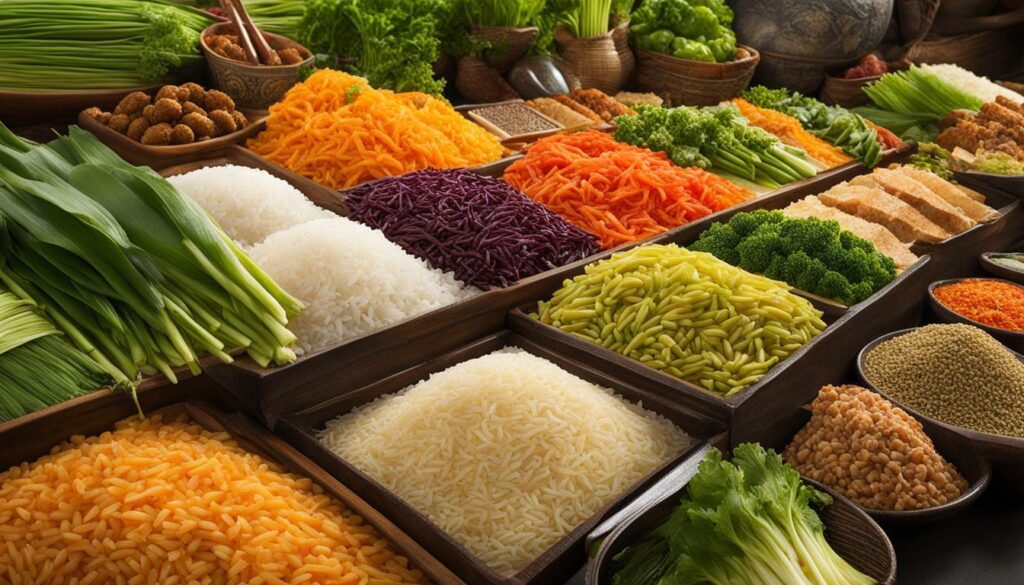
Staple Foods in Asia
Staple foods form the foundation of Asian diets, providing sustenance and cultural identity. These foods are not only a source of nourishment but also a reflection of the rich culinary heritage and diverse traditions of Asia. Rice, noodles, and grains are among the primary staples in many Asian countries, serving as the main source of carbohydrates.
In countries like China, Japan, and Thailand, rice is the staple food and is consumed in various forms, such as steamed rice, sushi, or rice noodles. Noodles, made from wheat, rice, or other grains, are also commonly consumed in Asian countries, with each region having its own variations and cooking methods.
To complement the staple grains, Asian diets often include a variety of vegetables, such as bok choy, bitter melon, and bamboo shoots. These vegetables not only add flavour and texture to the dishes but also provide essential vitamins, minerals, and dietary fibre. Fruits, such as mangoes, lychees, and dragon fruits, are enjoyed as snacks or desserts, offering a refreshing and sweet ending to a meal.
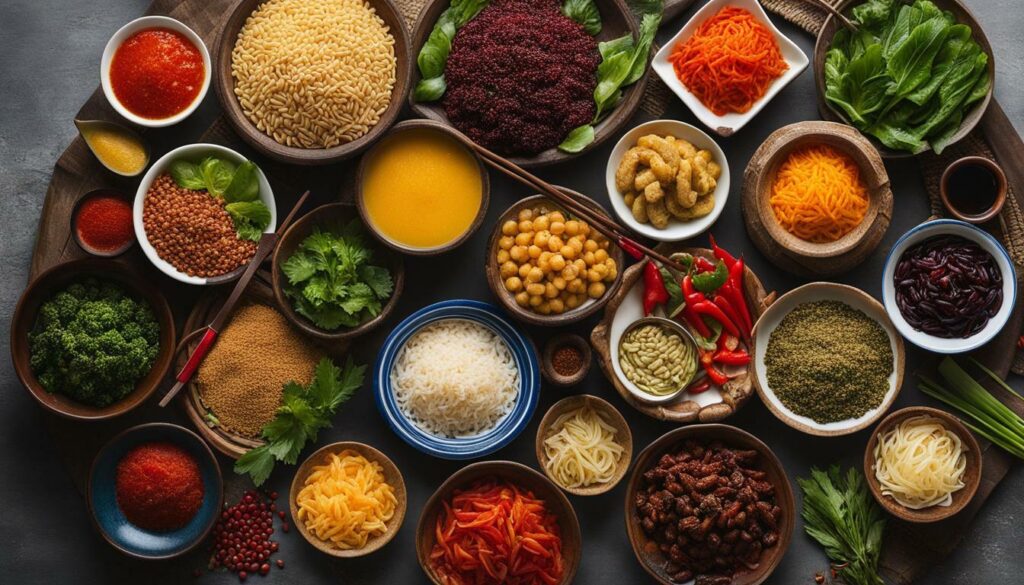
Asian diets also incorporate a moderate amount of protein, with fish, tofu, and soy-based products being popular choices. Fish, in particular, is often featured in main courses, owing to the abundance of coastal regions in Asia. The consumption of fish provides essential omega-3 fatty acids, which are beneficial for heart health.
Overall, Asian diets emphasize the use of fresh, whole foods, which not only contribute to a balanced and nutritious diet but also enhance the flavours and aromas of the dishes. The combination of staple foods, vegetables, fruits, and proteins creates a harmonious and satisfying culinary experience that has been cherished by Asian cultures for centuries.
Modern Adaptations of Asian Cuisine
Asian cuisine continues to evolve, with modern adaptations reflecting a blend of tradition and innovation. As culinary tastes change and global influences become more pronounced, Asian chefs and food enthusiasts are finding new ways to reimagine classic dishes and experiment with flavours, techniques, and ingredients. From fusion cuisine that combines elements from different Asian cultures to innovative cooking methods, the modern-day cuisines in Asia showcase the dynamism and creativity of the region’s culinary traditions.
One notable trend in modern Asian cuisine is the incorporation of international flavours and cooking styles. Chefs are exploring the fusion of Asian ingredients with Western culinary techniques, creating unique and exciting dishes that blend the best of both worlds. For instance, Japanese sushi rolls stuffed with avocado and cream cheese, or Thai curries infused with Mediterranean spices and herbs.
Another development in Asian cuisine is the rise of plant-based and vegetarian options. With the increasing focus on sustainability and health-conscious eating, many restaurants and home cooks are exploring innovative ways to create satisfying and flavorful vegetarian and vegan dishes. Traditional meat-based recipes are being adapted using plant-based proteins like tofu, tempeh, and seitan, while still retaining the distinct aromas and tastes of Asian spices and sauces.
| Modern Asian culinary techniques | Examples |
|---|---|
| Fusion cuisine |
|
| Plant-based and vegetarian options |
|
Asian cuisine has a rich and diverse heritage, and its modern adaptations reflect the region’s changing culinary landscape. From the fusion of different Asian flavors to the rise of vegetarian options, Asian cuisine continues to captivate food lovers worldwide with its unique blend of tradition and innovation.
Exploring bold flavours and innovative techniques
Asian chefs are also pushing the boundaries of flavour profiles and experimenting with unconventional ingredients. Umami, the savoury taste commonly associated with Asian cuisine, is being explored through the use of fermented foods, such as kimchi and miso. These ingredients add complexity and depth to dishes, elevating the dining experience.
Furthermore, innovative cooking techniques are gaining popularity in modern Asian cuisine. Sous vide, for example, is being used to create tender and flavorful meats, while traditional stir-frying techniques are being enhanced with higher heat and shorter cooking times to retain the freshness and crunchiness of vegetables. Chefs are also incorporating the art of plating and presentation to create visually stunning dishes that are both pleasurable to the eye and the palate.
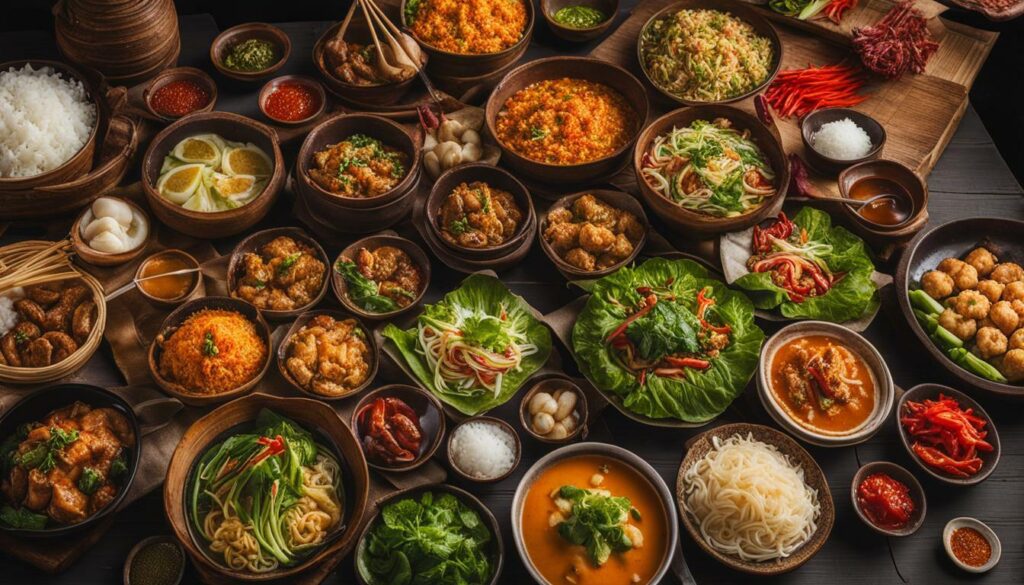
Asian cuisine continues to captivate food lovers worldwide with its ability to balance traditional flavours and techniques with contemporary culinary trends. Whether through fusion cuisine, plant-based options, or innovative cooking methods, the modern adaptations of Asian cuisine offer an exciting and dynamic culinary experience that pays homage to the region’s rich food culture while embracing new influences and ideas.
The evolving nature of Asian cuisine ensures that there is always something new and exciting to discover, making it a truly captivating and ever-changing culinary landscape.
Cultural Influences on Asian Diets
Cultural influences play a significant role in shaping the dietary practices of Asian communities. Throughout history, various cultural factors including religion, philosophy, and social customs have influenced the food choices and culinary practices in different Asian cultures.
The rich and diverse cultures across Asia have contributed to the development of unique culinary traditions. For example, in India, the cultural influence of Hinduism and its emphasis on vegetarianism has led to a predominantly plant-based diet, with dishes like lentils, vegetables, and dairy products being prominent. On the other hand, the influence of Buddhism in countries like Thailand and Myanmar has given rise to a cuisine that emphasizes the use of fresh herbs and spices in dishes that are often vegetarian-friendly.
Another instance of cultural influence can be seen in the dietary practices of East Asian countries. In China, the concept of “yin” and “yang” plays an integral role in food choices, with a focus on balancing contrasting flavours and ingredients to maintain harmony. Similarly, in Japan, the cultural practice of “washoku” emphasizes the harmony of taste, texture, and presentation in meals, with an emphasis on seasonal and fresh ingredients.
Table: Cultural Influences on Asian Diets
| Cultural Influence | Country | Dietary Practices |
|---|---|---|
| Hinduism | India | Vegetarianism, emphasis on lentils, vegetables, and dairy products |
| Buddhism | Thailand, Myanmar | Use of fresh herbs, spices, and vegetarian-friendly dishes |
| “Yin” and “Yang” | China | Focus on balancing contrasting flavors and ingredients |
| “Washoku” | Japan | Emphasis on taste, texture, and seasonal ingredients |
This intertwining of cultural and dietary practices in Asia has contributed to the diversity and richness of Asian cuisine. The cultural heritage of each region plays a vital role in shaping the ingredients, cooking methods, and flavour profiles of the dishes.
By understanding and celebrating the cultural influences on Asian diets, we not only gain insight into the vibrant history and traditions of the region but also develop an appreciation for the healthful and flavorful aspects of Asian culinary practices.
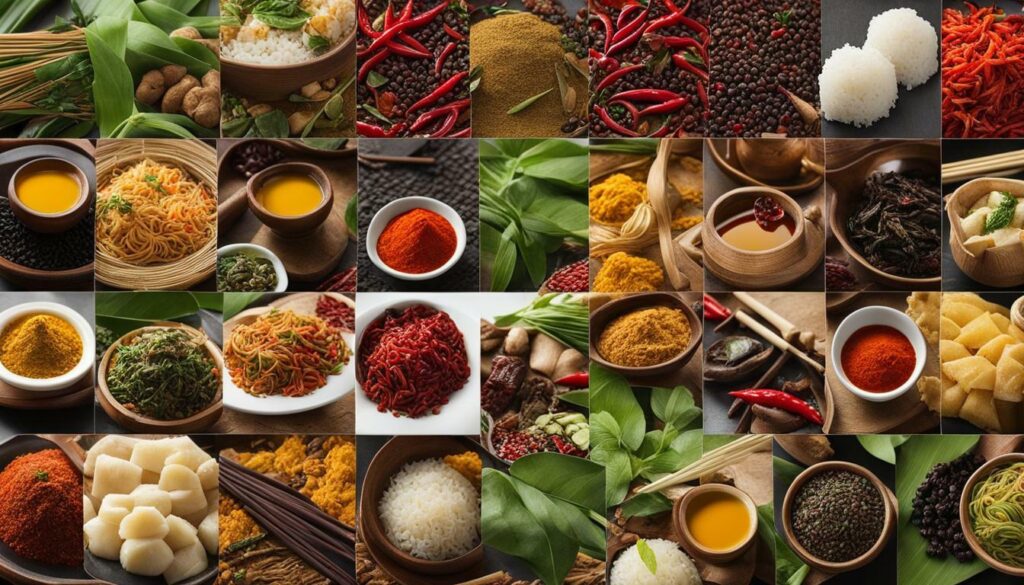
Asian diets are not only flavorful but also nutritionally balanced, focusing on wholesome foods for optimal health. The traditional Asian diet is predominantly plant-based, with an abundance of rice, vegetables, and fresh fruits. Meat is typically consumed in smaller portions, with fish often taking centre stage in main courses. This dietary pattern has been linked to lower rates of chronic illnesses such as heart disease, cancer, and obesity.
One of the key features of the Asian diet is its emphasis on grains, vegetables, fruits, nuts, and legumes. These food groups provide a rich source of vital nutrients, such as fibre, vitamins, and minerals. In contrast, meat and dairy consumption is moderate, ensuring a balance between protein intake and overall dietary diversity.
The updated Asian Diet Pyramid offers a visual representation of the recommended food groups and portion sizes. At the base of the pyramid are grains, highlighting their importance as a staple food in Asian cuisine. The subsequent levels include an abundance of vegetables and fruits, followed by protein sources like fish, poultry, and tofu. Finally, small portions of meat, dairy, and sweets are consumed sparingly.
| Food Group | Recommended Servings |
|---|---|
| Grains | 6-8 servings per day |
| Vegetables | 5-7 servings per day |
| Fruits | 2-3 servings per day |
| Protein (Fish, Poultry, Tofu) | 2-3 servings per day |
| Meat, Dairy, Sweets | Consumed sparingly |
Asian diets place a strong emphasis on the consumption of whole, unprocessed foods. This approach ensures that individuals benefit from the inherent nutrients found in these foods while minimizing the intake of added sugars, unhealthy fats, and preservatives. Furthermore, the Asian diet encourages mindfulness in eating, allowing individuals to savour the flavours, aromas, and textures of their meals.
Overall, the nutritional aspects of Asian diets provide a holistic approach to health and well-being. By incorporating a wide variety of plant-based foods and practising moderation in meat and dairy consumption, individuals can enjoy delicious and nutritious meals that promote optimal health and vitality.
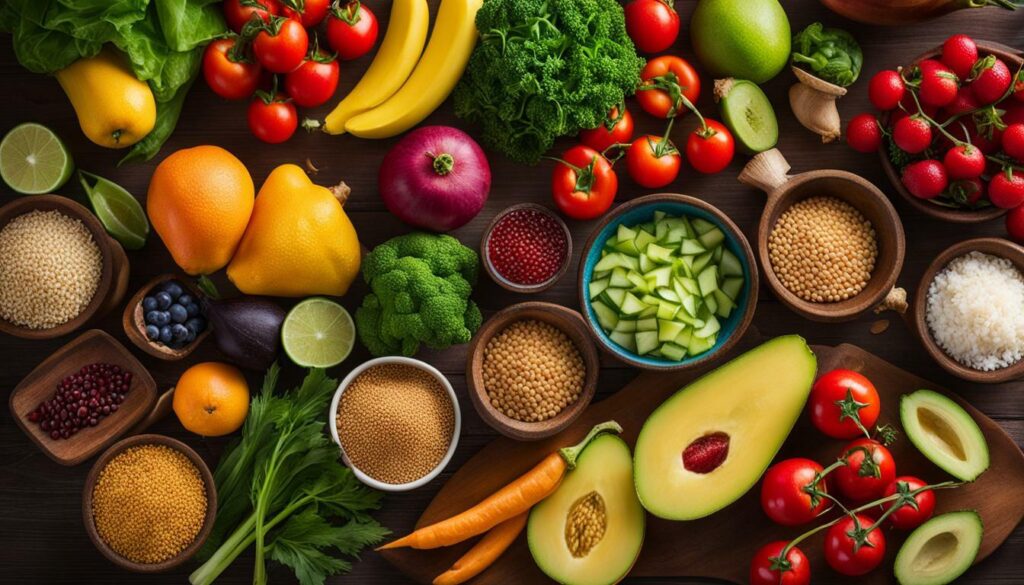
Asian cuisine is not just about nourishment but also about celebrating the joy of eating. With a rich culinary heritage and a wide array of flavours, aromas, and textures, Asian food culture is a feast for the senses. From the vibrant street food stalls of Thailand to the exquisite sushi restaurants of Japan, each Asian cuisine offers a unique culinary experience that captivates both locals and international food enthusiasts.
One of the distinct pleasures of Asian cuisine lies in the communal dining tradition. Sharing a meal with family and friends is deeply ingrained in Asian culture, fostering a sense of togetherness and connection. The dining table becomes a hub of conversation, laughter, and shared experiences, enhancing the overall enjoyment of the food.
Traditional cooking techniques further add to the pleasure of Asian cuisine. From stir-frying to steaming, each method is carefully executed to preserve the natural flavours and textures of the ingredients. The use of aromatic herbs and spices, such as lemongrass, ginger, and star anise, creates a harmonious balance of flavours that tantalizes the taste buds. Whether it’s the spicy curries of India or the delicate dumplings of China, each dish tells a story and transports the diner to a different culinary world.
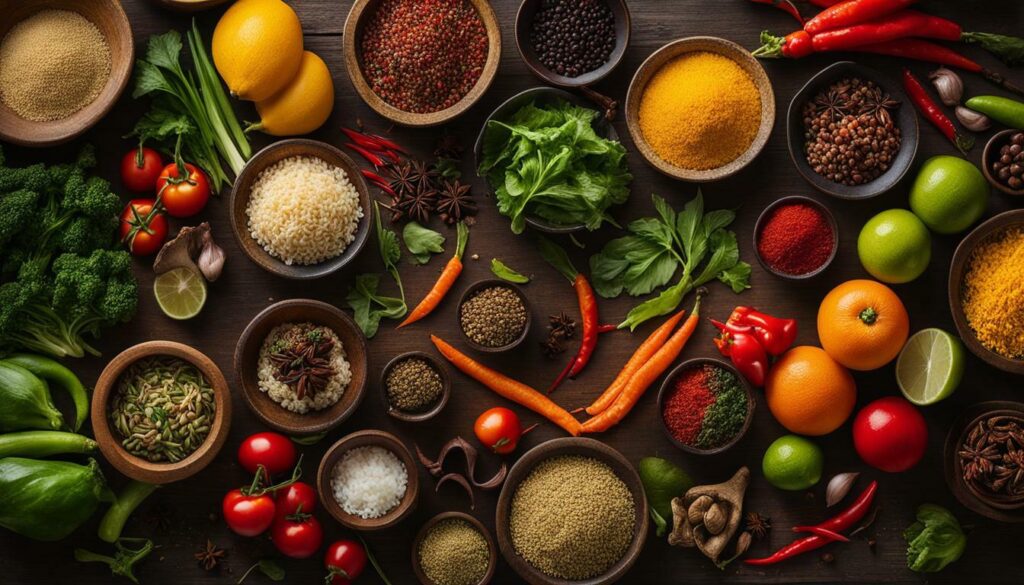
The beauty of Asian cuisine lies in its ability to offer a diverse range of dishes while still adhering to the principles of freshness and simplicity. With an abundance of fresh produce, Asian recipes often showcase the natural, vibrant colours of vegetables and fruits. With a focus on whole, unprocessed ingredients, the Asian diet promotes not only physical health but also a sense of well-being.
Experience the Pleasures of Asian Cuisine
Exploring Asian cuisine is a journey of taste, culture, and discovery. From street food adventures to fine dining experiences, there is something for everyone to relish. So, embark on this culinary adventure, savour the flavours, and immerse yourself in the pleasure of Asian cuisine.
Conclusion
The past and present diets of Asia offer a captivating glimpse into the culinary traditions that have shaped the continent’s diverse cultures. Throughout history, Asian cuisines have evolved, influenced by factors such as trade, migration, and colonialism. From traditional Asian diets, which are based on plant foods like rice, vegetables, and fresh fruits, to the modern adaptations and fusion cuisines that have emerged, Asian cuisine is rich in flavours and cultural significance.
The health benefits of the Asian diet are well-documented. Studies have shown that the Asian diet, with its emphasis on whole, unprocessed foods, is associated with lower rates of chronic illnesses, including heart disease, cancer, and obesity. The Asian Diet Pyramid, a visual representation of recommended food groups and portion sizes, highlights the importance of grains, vegetables, fruits, nuts, and legumes in the Asian diet, with moderation in meat and dairy consumption.
Regional variations in Asian cuisines add to the diversity of flavours and culinary traditions. From the variety of traditional foods in Indonesia to the rice and fish-based dishes in Japan, each region has its unique gastronomic delights. The blend of Chinese and Japanese influences in Korean food showcases the cross-cultural exchange that has shaped Asian cuisine over time.
The pleasure of Asian cuisine lies not only in its delicious flavours but also in the cultural significance attached to communal dining and traditional cooking techniques. Mindfulness in eating is emphasized, allowing individuals to fully appreciate the sensory experience of flavours, aromas, and textures that Asian food culture has to offer.
FAQ
What is the traditional Asian diet based on?
The traditional Asian diet is based on plant foods such as rice, vegetables, and fresh fruits.
What is the role of meat in the Asian diet?
Meat is rarely the main dish in the Asian diet, with fish often being consumed in main courses.
What are the health benefits of the Asian diet?
The Asian diet is known for its healthful qualities, with lower rates of chronic illnesses like heart disease, cancer, and obesity.
Are there different cuisines within Asia?
Yes, different regions in Asia have their own unique cuisines, such as the variety of traditional foods in Indonesia, the rice and fish-based dishes in Japan, and the blend of Chinese and Japanese influences in Korean food.
What does the Asian diet emphasize?
The Asian diet emphasizes grains, vegetables, fruits, nuts, and legumes, with meat and dairy being consumed in moderation.
Is there a visual representation of the recommended food groups and portion sizes in the Asian diet?
Yes, the updated Asian Diet Pyramid provides a visual representation of the recommended food groups and portion sizes.
Is the traditional Asian diet flavorful?
Yes, the traditional Asian diet is flavorful and satisfying, with a focus on fresh, whole foods.
Source Links
- https://www.encyclopedia.com/science/encyclopedias-almanacs-transcripts-and-maps/asian-diet
- https://oldwayspt.org/blog/introducing-updated-asian-diet-pyramid
- https://journalofethnicfoods.biomedcentral.com/articles/10.1186/s42779-019-0002-x



